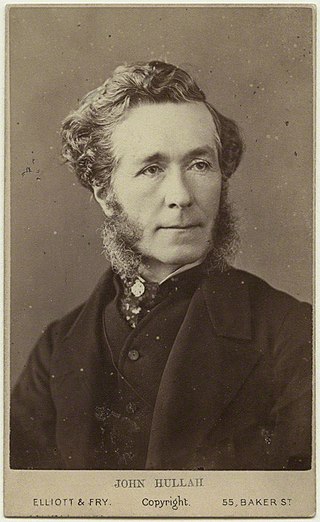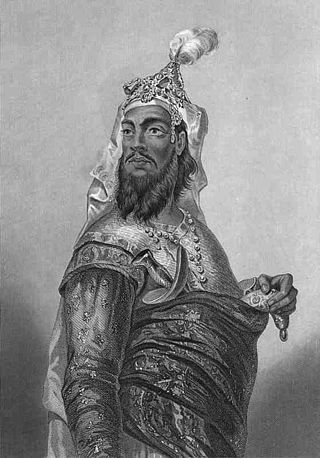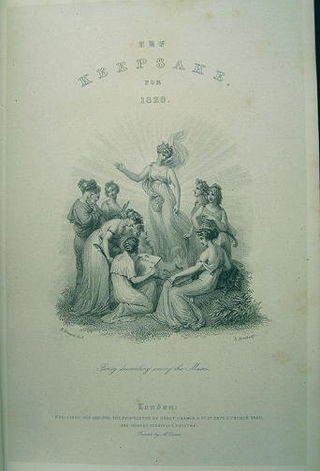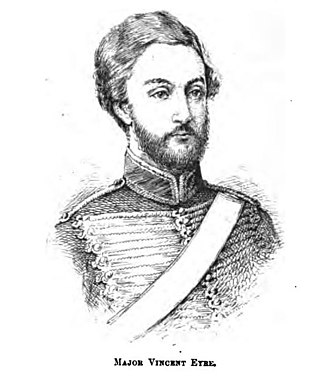
Sir John William Kaye was a British military historian, civil servant and army officer. His major works on military history include a three-volume work on The History of the Sepoy War in India. This work was revised later by George Bruce Malleson and published in six volumes in 1890 as Kaye and Malleson's History of the Indian Mutiny.

Jean-Baptiste Antoine Marcelin Marbot, known as Marcellin Marbot, was a French general, famous for his memoirs depicting the Napoleonic age of warfare. He belongs to a family that has distinguished itself particularly in the career of arms, giving three generals to France in less than 50 years. His elder brother, Antoine Adolphe Marcelin Marbot, was also a military man of some note.

The Indian Rebellion of 1857 was a major uprising in India in 1857–58 against the rule of the British East India Company, which functioned as a sovereign power on behalf of the British Crown. The rebellion began on 10 May 1857 in the form of a mutiny of sepoys of the Company's army in the garrison town of Meerut, 40 mi (64 km) northeast of Delhi. It then erupted into other mutinies and civilian rebellions chiefly in the upper Gangetic plain and central India, though incidents of revolt also occurred farther north and east. The rebellion posed a military threat to British power in that region, and was contained only with the rebels' defeat in Gwalior on 20 June 1858. On 1 November 1858, the British granted amnesty to all rebels not involved in murder, though they did not declare the hostilities to have formally ended until 8 July 1859. Its name is contested, and it is variously described as the Sepoy Mutiny, the Indian Mutiny, the Great Rebellion, the Revolt of 1857, the Indian Insurrection, and the First War of Independence.
George Robert Gleig was a Scottish soldier, military writer, and priest.

William Fraser McDonell VC was a British civil servant, judge and a recipient of the Victoria Cross, the highest award for gallantry in the face of the enemy that can be awarded to British and Commonwealth forces. He is one of only five civilians to have been awarded the VC.

John Pyke Hullah was an English composer and teacher of music, whose promotion of vocal training is associated with the singing-class movement.

Arrah is a city and a municipal corporation in Bhojpur district in the Indian state of Bihar. It is the headquarters of Bhojpur district, located near the confluence of the Ganges and Sone rivers, some 24 mi (39 km) from Danapur and 36 mi (58 km) from Patna.
Danapur Cantonment or Danapur Cantt is a cantonment town in Patna District in the state of Bihar, India. Danapur is a category II cantonment, established in 1765. The board consists of 14 members including 7 elected members. Danapur Cantonment, located on the outskirts of Patna, is the second oldest cantonment in India, after Barrackpur Cantonment, West Bengal. Danapur is the regimental centre of the Bihar Regiment (BRC). It was earlier called Bankipore Cantonment. Initially, it was set up at Bankipore but later set up in the Danapur area in 1766–67.

Arthur Hill Hassall was a British physician, chemist and microscopist who is primarily known for his work in public health and food safety.

Kunwar Singh, also known as Babu Kunwar Singh, was a leader and military commander during the Indian Rebellion of 1857. He led a selected band of armed soldiers against the troops under the command of the British East India Company. He was the chief organiser of the fight against the British in Bihar.
William Reeves was an Irish antiquarian and the Church of Ireland Bishop of Down, Connor and Dromore from 1886 until his death. He was the last private keeper of the Book of Armagh and at the time of his death was President of the Royal Irish Academy.

The Keepsake was an English literary annual which ran from 1828 to 1857, published each Christmas from 1827 to 1856, for perusal during the year of the title. Like other literary annuals, The Keepsake was an anthology of short fiction, poetry, essays, and engraved illustrations. It was a gift book designed to appeal to young women, and was distinctive for its binding of scarlet dress silk and the quality of its illustrations. Although the literature in The Keepsake and other annuals is often regarded as second-rate, many of the contributors to The Keepsake are canonical authors of the Romantic period.

The 45th Rattray's Sikhs was an infantry regiment of the British Indian Army. They could trace their origins to the 1st Bengal Military Police Battalion raised in April 1856, at Lahore, by Captain Thomas Rattray originally consisting of a troop of 100 cavalry and 500 infantry. The initial class composition of the troops was 50% Sikhs and 50% Dogras, Rajputs and Mussulmans (Muslims) from the Punjab and the North-West Frontier. It is said that he went through the villages challenging men to wrestle with him on the condition that they had to join up. Whatever the case, the regiment was raised and trained and developed as an elite corps, which soon saw action in Bihar in the Sonthal 'parganas'. After sterling service in Bihar, Bengal and Assam, and during the 1857 Mutiny, the cavalry portion was eventually disbanded in 1864 and the infantry section was taken into the line of Bengal Native Infantry as the '45th Native Regiment of Infantry'.

Major-General Sir Vincent Eyre was an officer in the Indian Army, who saw active service in India and Afghanistan.
James Talboys Wheeler was a bureaucrat-historian of the British Raj.

This Bibliography covers sources for Royal Navy history through the 18th and 19th centuries. Some sources may be duplicated in sections when appropriate. Among the contemporary and earlier historical accounts are primary sources, historical accounts, often derived from letters, dispatches, government and military records, captain's logs and diaries, etc., by people involved in or closely associated to the historical episode in question. Primary source material is either written by these people or often collected, compiled, and/or written and published by other editors also, sometimes many years after the historical subject has passed. Primary sources listed in this bibliography are denoted with an uppercase bold ' (P) before the book title. Publications that are in the public domain and available online for viewing in their entirety are denoted with E'Book.
The translations of One Thousand and One Nights have been made into virtually every major language of the world. They include the French translation by Antoine Galland. Galland's translation was essentially based on a medieval Arabic manuscript of Syrian origins, supplemented by oral tales recorded by him in Paris from a Maronite Arab from Aleppo named Hanna Diyab.

The siege of Arrah took place during the Indian Mutiny. It was the eight-day defence of a fortified outbuilding, occupied by a combination of 18 civilians and 50 members of the Bengal Military Police Battalion, against 2,500 to 3,000 mutinying Bengal Native Infantry sepoys from three regiments and an estimated 8,000 men from irregular forces commanded by Kunwar Singh, the local zamindar or chieftain who controlled the Jagdishpur estate.
Richard Vicars Boyle (1822–1908) was an Irish civil engineer, noted for his part in the Siege of Arrah in 1857, and as a railway pioneer in Japan.
Igbo literature is the spoken and written literature of the Igbo people. Before the advents of writing, Igbos practiced oral literature, folk songs and poetry.













